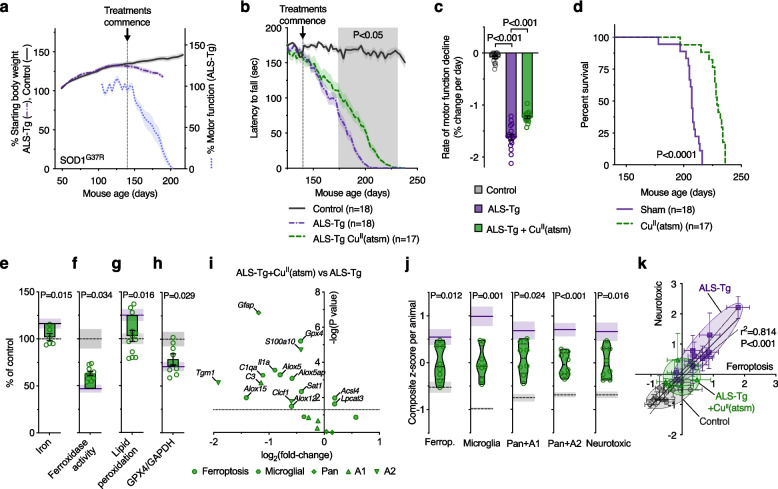Fig. 7.
Treatment with CuII(atsm) is protective and mitigates markers of ferroptosis and glial activation in ALS model mice. a Stage of phenotype progression in transgenic SOD1G37R ALS model mice (ALS-Tg) at which treatment with CuII(atsm) commenced for the present study. Percentage starting body weight for SOD1G37R mice is expressed relative to body weight per animal at 50 days old. Percentage motor function (rotarod assay) is expressed relative to average performance per animal over the period 125–139 days (n = 14–21 animals). b Effect of CuII(atsm) at 30 mg/kg body weight twice daily on motor function of SOD1G37R mice. c Rate of motor function decline in SOD1G37R mice derived from data in b. d CuII(atsm), administered orally commencing at the post symptom-onset age of 140 days, extends survival of the SOD1G37R mouse model of ALS. e-h Therapeutic outcomes for CuII(atsm) in the SOD1G37R mice are associated with improved biochemical markers of ferroptosis, including decreased iron levels, increased ferroxidase activity, decreased lipid peroxidation and increased GPX4 protein in extracted spinal cord tissue. Lipid peroxidation in g measured as oxidised:reduced C11-BODIPY. i Volcano plot of transcript analyses for genes associated with ferroptosis and neurotoxic glial activation in SOD1G37R mouse spinal cord tissue treated with CuII(atsm) compared to SOD1G37R mice without CuII(atsm) treatment. j Overall transcript signature for ferroptosis and neurotoxic glial genes are mitigated by CuII(atsm) treatment, including genes associated with neurotoxicity in vitro (Neurotoxic), derived from i and Fig. 5g-j. k Correlation between overall transcript signatures for ferroptosis and neurotoxic glia (from j and Fig. 5h, j). Symbols represent individual animals. In e-h, j, data points represent individual SOD1G37R mice treated with CuII(atsm); purple solid lines and grey dashed lines and represent mean of SOD1G37R without CuII(atsm) treatment and control non-transgenic littermates, respectively. Error margins are S.E.M. in line plots (a, b), bar graphs (c, e-h), violin plots (j) and overall transcript signatures of individual animals (k), or 95% confidence interval of linear regression (dashed lines) in correlation plot (k). Solid lines in violin plots (j) represent median, dotted lines represent 25th/75th percentiles, truncated at min-max values. P values indicate significant differences between groups (c, d), significance of correlation (k), or significant difference between SOD1G37R mice treated with or without CuII(atsm) (shaded area, b; e-h, j)

